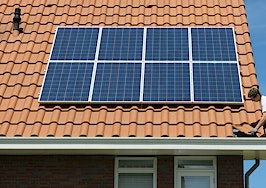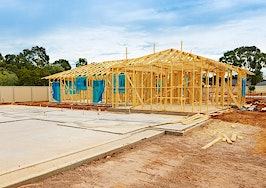Residential flooring options were once very simple. Hardwood floors were a standard in living and dining rooms, hallways and bedrooms. Ceramic tile was common in bathrooms, and vinyl tile in kitchens and recreation rooms.
Buyers of new construction were faced with the minimal decision of what stain to use on their wood floors and what color ceramic floor to choose for their bathrooms. Kitchen vinyl tiles offered the biggest selection of colors and in some cases, patterns, too.
That’s different now. Today’s homebuyers are faced with an almost endless selection of flooring materials, the most popular and most durable of which is laminate flooring.
What is laminate flooring?
Laminate flooring is a synthetic substance that accurately simulates the appearance of wood flooring with its visual imaging of wood and embossed wood grain on each plank. High-quality, “luxury” laminate floors have a high-resolution photograph of natural wood as their top layer, in the same way plastic laminate countertops simulate marble or other textures.
The composition of laminate flooring contains wood, which makes it feel warmer and slightly soft. The representation of wood in a laminate floor is a computer-generated image of wood flooring. Unlike real wood flooring — in which every plank is different because every tree is unique — the pattern in laminate flooring will repeat itself.
This repetition will be evident in wide open spaces with no area rugs or furniture. Very few homebuyers will notice the pattern of the laminate flooring being similar, and new manufacturing methods (which will be addressed later) are making this less of an issue.
What is vinyl flooring?
Vinyl flooring is sometimes confused with laminate flooring. Consisting of 100 percent plastic, vinyl flooring does not accurately imitate wood flooring to the degree that laminate flooring can.
Vinyl flooring will withstand constant moisture much better than laminate flooring, and is in fact more expensive and longer-lasting. The biggest difference between laminate and vinyl is appearance. The majority of homeowners consider vinyl flooring to be less aesthetically pleasing and less “real” than laminate floors.
Laminate flooring versus hardwood flooring
There are quite a few reasons, other than appearance, to consider laminate flooring. Wood flooring is the gold standard in housing, but it requires maintenance and upkeep.
Hardwood flooring, which laminate floors aspire to imitate, are best installed by professionals with special nailing tools. Finding a home with well-maintained hardwood floors, or floors that have been preserved under wall-to-wall carpeting for many years, is the goal of many homebuyers.
As an agent, if you list a home with original hardwood floors, make sure to feature it in the listing details. Wall-to-wall carpeting is less in demand today than ever, and if your listing has carpeting over hardwood floors, obtain permission from the seller to lift a corner of the carpeting in one or two rooms to expose the wood beneath. This is full disclosure — and will help you sell the listing.
Hardwood floors installed in a raw, rather than prefinished state, are sanded and then stained after installation. Sealing the final result will help maintain the finish. Homes with large windows or large expanses of glass that are uncovered, allowing unfiltered sunlight in, will fade wood floors over time. The consistency of grain, tone and permanency of color in laminate floors is a prime reason they are so popular.
Installation of a laminate wood floor is far simpler than hardwood, as the planks are not nailed down or glued to a subfloor. Laminate flooring is installed over an underlayment foam that is usually two millimeters thick.
This underlayment absorbs some sound and allows the flooring to bounce back when you walk on it. The planks are usually installed parallel to the longest wall, and rather than glued or nailed in place, they “click into place,” with each piece connecting to its adjoining section.
Do-it-yourself homeowners can install laminate over a smooth, level and dry surface without too much anxiety. The ease of installation, modest price, impressive appearance and wide variety of patterns and colors make this flooring the choice of home renovators and sellers eager for a quick fix when existing floors are damaged beyond repair.
Replacing a few planks or a large damaged area is not as involved as removing, replacing, sanding and refinishing hardwood flooring that may not be an accurate match to the existing flooring.
Originally produced in 36-inch and 48-inch planks, some laminate flooring is now available in 60-inch and 72-inch planks. Longer planks install more quickly than shorter ones, and they prevent the pattern repetition that some homeowners find objectionable.
Much like with hardwood floors, humidity will affect laminate flooring. That’s why it’s best to maintain a consistent level of humidity (around 40 to 50 percent).
Although not waterproof, laminate flooring experiences little of the expansion and contraction of hardwood floors. What’s more, laminate flooring can be installed over in-ground electric heating cables, as long as the temperature remains under 85 degrees.
Finally, taking care of laminate flooring is far easier than hardwood flooring. It’s always best to sweep or vacuum debris and then simply damp-mop with a gentle household cleaner. Laminates are ideal for homes where pets and children reside, and where easy clean-up is necessary.
As a real estate agent, it counts to be well-versed on flooring options. Whether they’re selling or buying a home, your clients will appreciate your know-how and expertise in helping them problem-solve flooring issues.
Gerard Splendore is a licensed associate real estate broker with Warburg Realty in New York. Connect with him on LinkedIn.









